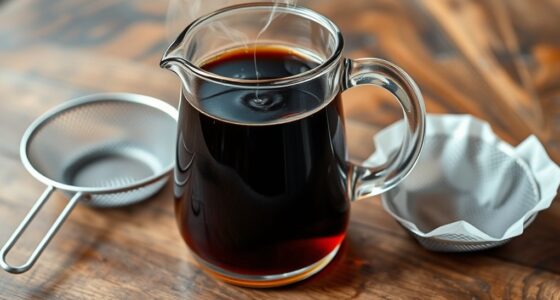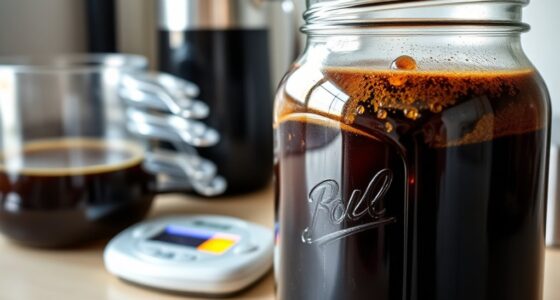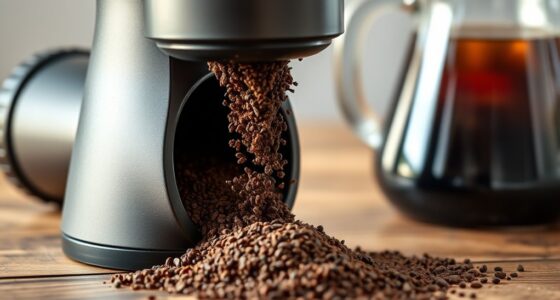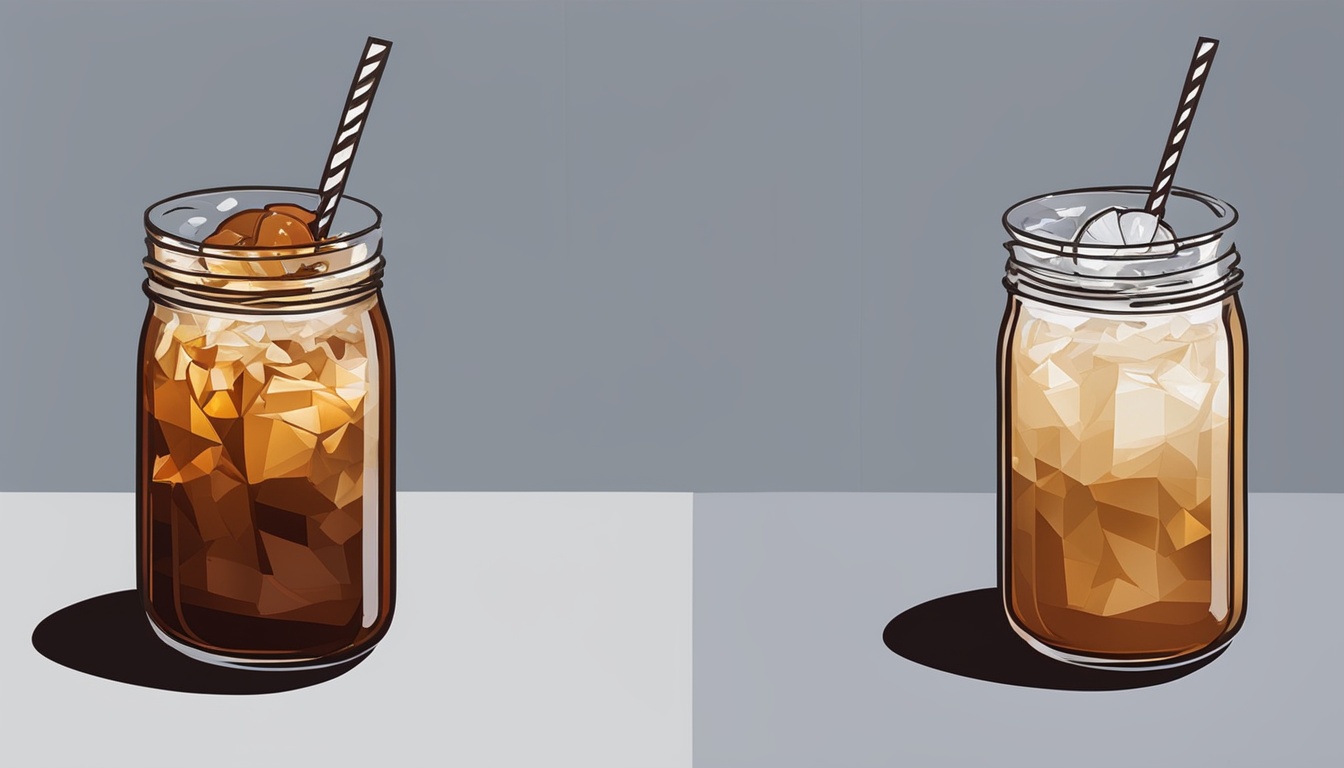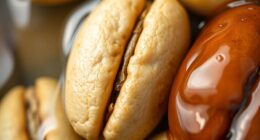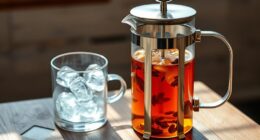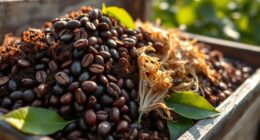To dial in your cold brew, start with a strong concentrate using a 1:4 or 1:5 coffee-to-water ratio, then dilute it to your desired strength for a ready-to-drink. Adjust the ratio based on your flavor preference—more coffee for a robust taste or less for a lighter brew. Using a precise scale guarantees consistency, and experimenting with ratios helps find your perfect balance. Continue exploring to master your ideal cold brew strength and flavor.
Key Takeaways
- Start with common ratios like 1:4 or 1:5 for concentrates, then adjust based on desired strength and flavor.
- Use a scale for precise measurements to ensure consistent ratios across batches.
- Experiment with different ratios to find the balance between smoothness and flavor intensity.
- Remember that higher concentration (e.g., 1:3) results in a richer, bolder flavor, while lower ratios yield milder taste.
- Record successful ratios and tweak gradually to perfect your cold brew for both concentrate and ready-to-drink servings.
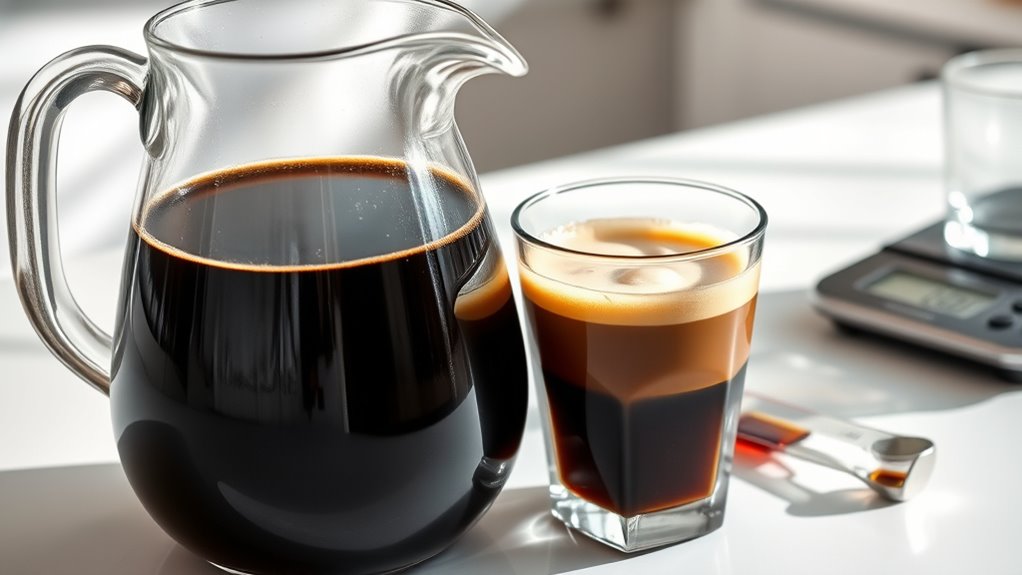
Have you ever wondered how to get the perfect cold brew coffee? Achieving that ideal balance isn’t just about steeping coffee grounds in water; it’s about understanding cold brew ratios and how they influence flavor and strength. When it comes to brewing techniques, the ratio of coffee to water plays a vital role in determining whether your cold brew will be smooth and rich or weak and watery. Starting with the right ratio ensures you can fine-tune your brew to suit your taste. Typically, a common starting point is using a 1:4 or 1:5 coffee-to-water ratio for a concentrate, which means for every part coffee, you add four or five parts water. But don’t just settle there—experiment to find what works best for your preferred flavor profile.
Flavor balancing is key when dialing in your cold brew. A higher coffee concentration yields a more intense, robust flavor, while a lower ratio results in a milder, more delicate taste. If you love a strong, full-bodied coffee, you might prefer a 1:3 or even 1:2 ratio to create a concentrate that can be diluted later. Conversely, if you prefer a ready-to-drink brew that’s less intense, sticking closer to the 1:5 or 1:6 ratio allows you to enjoy a smoother, more balanced cup straight away. Remember, the ratio isn’t just about strength; it also impacts how the flavors develop during brewing. Using the right amount of coffee guarantees you don’t end up with over-extraction, which can lead to bitterness, or under-extraction, resulting in a weak, flat taste. Additionally, choosing the appropriate tuning techniques can help optimize flavor extraction and clarity.
To get the most consistent results, measure your coffee and water precisely. A kitchen scale is invaluable here, helping you maintain accurate ratios every time. When you set up your brewing process, consider your taste preferences and how you plan to serve your cold brew—whether straight, over ice, or diluted with milk or sweeteners. Adjusting the ratio based on these factors will give you better control over flavor balancing. Keep in mind that brewing techniques, such as immersion or slow-steep methods, also influence the final profile, but the ratio remains one of the most straightforward ways to control strength and flavor. Once you find a ratio that suits your palate, note it down. From there, you can tweak it slightly to refine your perfect cold brew, ensuring each batch meets your expectations with clarity and precision.
Frequently Asked Questions
How Long Can Cold Brew Concentrate Be Stored Safely?
You can store cold brew concentrate safely for up to two weeks in the refrigerator. To prevent spoilage, keep it in an airtight container and avoid temperature fluctuations. After this period, flavor and quality may decline, and spoilage could occur. Always smell and taste a small amount before using it beyond two weeks, and if you notice any off odors or changes in appearance, discard it to guarantee safety.
What Water Temperature Works Best for Diluting Cold Brew?
You’ll get the best dilution effectiveness with cold water around 40°F to 50°F. This range balances temperature and solubility, ensuring smooth flavor without over-dilution. Did you know that water at this temperature dissolves cold brew concentrate efficiently, making your drink taste consistent? Avoid hot water, which can weaken flavors, or ice-cold water, which may slow dilution. Stick to 40-50°F for ideal results.
How Do I Adjust Ratios for Different Grind Sizes?
You should adjust ratios based on grind consistency because finer grinds increase extraction rate, leading to a stronger brew, so use less concentrate. Conversely, coarser grinds slow extraction, requiring more concentrate for balanced flavor. Experiment by slowly changing ratios and tasting until you find the ideal balance. Keep in mind, consistent grind size guarantees predictable extraction, making ratio adjustments more precise and your cold brew consistently delicious.
Can I Use Alternative Milks or Liquids With Cold Brew?
You can definitely use alternative milks or liquids with cold brew, adding a new flavor dimension. Think of it as blending familiar with the unexpected—soy, oat, or almond milk can create creamy, personalized drinks. You might also infuse your cold brew with flavors like vanilla or cinnamon. Experimenting with different liquids lets you customize your cold brew experience, making each cup uniquely yours while maintaining that smooth, rich texture you love.
What Are the Health Benefits of Cold Brew Coffee?
Cold brew coffee offers health benefits like antioxidant properties that help combat free radicals, supporting your overall health. It also boosts mental alertness, keeping you focused and energized throughout your day. You might find it easier to enjoy these benefits with less acidity than hot coffee, making it gentler on your stomach. Drinking cold brew regularly can contribute to improved mood, concentration, and long-term health.
Conclusion
Finding the perfect cold brew ratio is like tuning a musical instrument—you’ll get better harmony with patience and experimentation. Don’t be afraid to tweak the concentrate-to-water ratio until it sings just right for your taste. Remember, even a small adjustment can turn a good brew into a great one. Keep experimenting, stay curious, and soon you’ll master the art of dialing in your ideal cold brew, making every sip a symphony of flavor.


